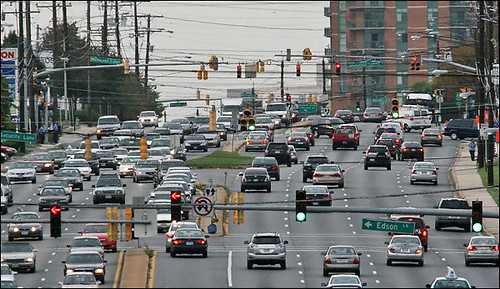Calgary and its new planning director Rollin Stanley
Rollin Stanley, the director of land use planning for Montgomery County, Maryland, is going to become the director of planning, development, and [tax] assessment for the City of Calgary, Alberta. Stanley is controversial, a change agent, and while may have been out of his element--he's definitely a city guy--as the planning director in a County (see "Planning Director Retracts Controversial Statements" from the Bethesda Patch blog), there is no question that he has pushed forward some truly transformative approaches to suburban planning, intensifying development, the transformation of the White Flint area of Rockville Pike, and considering the future of traditional subdivision development as the residential population ages out.
But Calgary is as equally interesting.
Christopher Hume of the Toronto Star has written a couple of articles "Calgary Mayor makes us look like rednecks" and "'Canada's mayor' sees the city positively," about Calgary's progressive mayor, Naheed Nenshi. More than most of his colleague mayors across North America, Nenshi has a focused agenda and has spent a lot of time thinking about his city, cities generally, and Calgary's future.
From the first article:
Not only is Nenshi the first member of a visible minority to be elected mayor of Calgary, he’s the first Muslim chosen to run a major Canadian city. His campaign emphasized urban revitalization. Nenshi’s passion, he explains, is cities. As lead author of Building Up: Making Canada’s Cities Engines of Growth and Magnets of Development, he has definite ideas about to help cities work better for all residents.
Unlike Ford, whose five-step plan for Toronto has yet to progress beyond the anger stage, Nenshi talks eloquently about what Calgary could become. He doesn’t see a boom-and-bust oil industry centre, but a fully realized city, diverse, urban and transit-based. He has argued against sprawl and insists that he will make all Calgary’s neighbourhoods safer, greener and more engaging. He focuses on the physical realm as much as issues of municipal governance.
Calgary is a boomtown because of oil, although Edmonton is more central to the industry. But while the city has been trying to reform itself out of sprawl ("Toronto can learn a lot from Calgary" from the Toronto Star, 2007), it's also "conservative" ("Dynamic Calgary holds historic vote in hand," "For Quebec, Canada's westward shift translates into ‘de facto separation'" and "Alberta’s urban centres: A tale of two cities' parties" from the Toronto Globe & Mail) and it will be interesting to watch how Rollin functions out there.
Before he was in Montgomery County he was in St. Louis, and one of his presentations on the urban revitalization strategy for the city won an international award. It's on page 127 of this document, The future of shrinking cities: problems, patterns, and strategies of urban transformations in a global context.

Rockville Pike, Washington Post photo by Bill O'Leary.
Labels: land use planning, sprawl, transportation planning, urban revitalization




1 Comments:
This should be good for Calgary. Calgary is an amazing city with natural resources and a great entreprenurial population.
Montgomery triangle is awesome!!
Post a Comment
<< Home